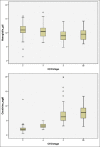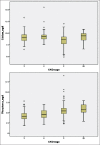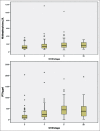Prevalence and severity of disordered mineral metabolism in patients with chronic kidney disease: A study from a tertiary care hospital in India
- PMID: 27366711
- PMCID: PMC4911834
- DOI: 10.4103/2230-8210.183457
Prevalence and severity of disordered mineral metabolism in patients with chronic kidney disease: A study from a tertiary care hospital in India
Abstract
Background: Disordered mineral metabolism is common complications of chronic kidney disease (CKD). However, there are limited data on the pattern of these disturbances in Indian CKD population.
Materials and methods: This was a prospective observational study of CKD-mineral and bone disorder (CKD-MBD) over a period of 3 years. The biochemical markers of CKD-MBD, namely, calcium, phosphorus, alkaline phosphatase, intact parathyroid hormone (iPTH), and 25-hydoxyvitamin Vitamin D3 (25OHD), were measured in newly diagnosed CKD Stage 3-5 and prevalent CKD Stage 5D adult patients.
Results: A total of 462 patients of CKD Stage 3-5D were studied. The frequency of various biochemical abnormalities was hypocalcemia (23.8%), hypercalcemia (5.4%), hypophosphatemia (2.8%), hyperphosphatemia (55.4%), raised alkaline phosphatase (56.9%), secondary hyperparathyroidism (82.7%), and hypoparathyroidism (1.5%). 25OHD was done in 335 (72.5%) patients and 90.4% were found to have Vitamin D deficiency. About 70.6% of the patients had iPTH levels were above kidney disease outcomes quality initiative (KDOQI) target range. Nondiabetic CKD as compared to diabetic CKD had a higher alkaline phosphatase (P = 0.016), a higher iPTH (P = 0.001) a higher proportion of patients with iPTH above KDOQI target range (P = 0.09), and an elevated alkaline phosphatase (P = 0.004). The 25OHD levels were suggestive of severe Vitamin D deficiency in 33.7%, Vitamin D deficiency in 45.4%, and Vitamin D insufficiency in 11.3% patients. There was a significant positive correlation between iPTH with alkaline phosphatase (r = 0.572, P = 0.001), creatinine (r = 0.424, P = 0.001), and phosphorus (r = 0.241, P = 0.001) and a significant negative correlation with hemoglobin (r = -0.325, 0.001), age (r = -0.169, P = 0.002), and 25OHD (r = -0.126, P = 0.021). On multivariate logistic regression analysis, an elevated alkaline phosphatase was a significant predictor of hyperparathyroidism (odds ratio 9.7, 95% confidence interval 4.9-19.2, P = 0.001).
Conclusions: There was a high prevalence of CKD-MBD in Indian CKD patients. CKD-MBD is more common and more severe and has an early onset as compared to the western populations.
Keywords: Chronic kidney disease; Vitamin D; chronic kidney disease-mineral and bone disorder; hyperparathyroidism; hyperphosphatemia; hypocalcemia; mineral metabolism disorder.
Figures





Similar articles
-
Profile of chronic kidney disease related-mineral bone disorders in newly diagnosed advanced predialysis diabetic kidney disease patients: A hospital based cross-sectional study.Diabetes Metab Syndr. 2017 Dec;11 Suppl 2:S931-S937. doi: 10.1016/j.dsx.2017.07.019. Epub 2017 Jul 8. Diabetes Metab Syndr. 2017. PMID: 28728874
-
The high prevalence of chronic kidney disease-mineral bone disorders: A hospital-based cross-sectional study.Indian J Nephrol. 2012 Jul;22(4):285-91. doi: 10.4103/0971-4065.101249. Indian J Nephrol. 2012. PMID: 23162273 Free PMC article.
-
Study of chronic kidney disease-mineral bone disorders in newly detected advanced renal failure patients: A Hospital-based cross-sectional study.Saudi J Kidney Dis Transpl. 2017 Jul-Aug;28(4):874-885. Saudi J Kidney Dis Transpl. 2017. PMID: 28748891
-
Chronic Kidney Disease-Mineral Bone Disease Biomarkers in Kidney Transplant Patients.Curr Med Chem. 2022 Aug 15;29(31):5230-5253. doi: 10.2174/0929867329666220318105856. Curr Med Chem. 2022. PMID: 35306980 Review.
-
CKD, arterial calcification, atherosclerosis and bone health: Inter-relationships and controversies.Atherosclerosis. 2018 Nov;278:49-59. doi: 10.1016/j.atherosclerosis.2018.08.046. Epub 2018 Aug 30. Atherosclerosis. 2018. PMID: 30253289 Review.
Cited by
-
Estimating the global prevalence of secondary hyperparathyroidism in patients with chronic kidney disease.Front Endocrinol (Lausanne). 2024 Jun 21;15:1400891. doi: 10.3389/fendo.2024.1400891. eCollection 2024. Front Endocrinol (Lausanne). 2024. PMID: 38974573 Free PMC article.
-
Hypophosphataemia risk associated with ferric carboxymaltose in heart failure: A pooled analysis of clinical trials.ESC Heart Fail. 2023 Apr;10(2):1294-1304. doi: 10.1002/ehf2.14286. Epub 2023 Feb 1. ESC Heart Fail. 2023. PMID: 36722321 Free PMC article.
-
Ferric Carboxymaltose in Iron-Deficient Patients with Hospitalized Heart Failure and Reduced Kidney Function.Clin J Am Soc Nephrol. 2023 Sep 1;18(9):1124-1134. doi: 10.2215/CJN.0000000000000223. Epub 2023 Jun 29. Clin J Am Soc Nephrol. 2023. PMID: 37382961 Free PMC article. Clinical Trial.
-
Mineral Bone Disease Prevalence and Biochemical Profile in Chronic Kidney Disease Patients Undergoing Hemodialysis.Cureus. 2025 May 24;17(5):e84747. doi: 10.7759/cureus.84747. eCollection 2025 May. Cureus. 2025. PMID: 40551948 Free PMC article.
-
Prevalence of Chronic Kidney Disease-Mineral Bone Disorder in Hemodialysis Patients in Hebei, China.Chin Med J (Engl). 2018 Nov 20;131(22):2749-2751. doi: 10.4103/0366-6999.245264. Chin Med J (Engl). 2018. PMID: 30425204 Free PMC article. No abstract available.
References
-
- Coresh J, Astor BC, Greene T, Eknoyan G, Levey AS. Prevalence of chronic kidney disease and decreased kidney function in the adult US population: Third National Health and Nutrition Examination Survey. Am J Kidney Dis. 2003;41:1–12. - PubMed
-
- Coresh J, Selvin E, Stevens LA, Manzi J, Kusek JW, Eggers P, et al. Prevalence of chronic kidney disease in the United States. JAMA. 2007;298:2038–47. - PubMed
-
- Furuhashi T, Moroi M, Joki N, Hase H, Masai H, Kunimasa T, et al. The impact of chronic kidney disease as a predictor of major cardiac events in patients with no evidence of coronary artery disease. J Cardiol. 2010;55:328–36. - PubMed
-
- Keith DS, Nichols GA, Gullion CM, Brown JB, Smith DH. Longitudinal follow-up and outcomes among a population with chronic kidney disease in a large managed care organization. Arch Intern Med. 2004;164:659–63. - PubMed
-
- Moe S, Drüeke T, Cunningham J, Goodman W, Martin K, Olgaard K, et al. Definition, evaluation, and classification of renal osteodystrophy: A position statement from kidney disease: Improving global outcomes (KDIGO) Kidney Int. 2006;69:1945–53. - PubMed
LinkOut - more resources
Full Text Sources
Other Literature Sources

